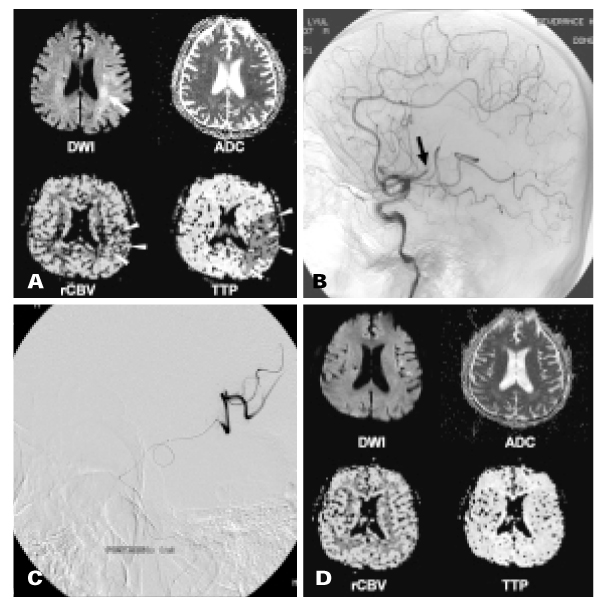J Korean Med Assoc.
2004 Jul;47(7):611-619. 10.5124/jkma.2004.47.7.611.
Imaging Diagnosis of Occlusive Cerebrovascular Diseases and Cerebral Infarction
- Affiliations
-
- 1Department of Diagnostic Radiology, Yonsei University College of Medicine, Severance Hospital, Korea. slee@yumc.yonsei.ac.kr
- KMID: 2183479
- DOI: http://doi.org/10.5124/jkma.2004.47.7.611
Abstract
- Non-contrast CT scan still plays a major role in the diagnosis of ischemic stroke, differentiation from hemorrhagic stroke, and determination of therapeutic plans. However, recently introduced perfusion CT and CT angiography using multi-slice CT are now widely used in the clinical field. They provide information about the local hemodynamic status and the exact location of occlusion in the same way as perfusion MRI and MR angiography. Diffusion-weighted MRI describes the status of molecular diffusion of the brain tissue and detects cytotoxic edema, which enables diagnosis of acute stroke in a more sensitive way than CT or conventional T2-weighted MRI. Perfusion MRI using gadolinium contrast is more sensitive and can detect hyperacute stroke even at the time of occlusion. A proper combination of PWI and DWI can evaluate the brain tissue at risk, e.g. ischemic penumbra, by detection of DWI/PWI mismatching areas and enables the timely diagnosis and treatment of acute stroke. MR angiography also provides an anatomic detail of stenosis or occlusion of cerebral vessels by the non-contrast TOF or contrastenhanced technique. Understanding the principles and pitfalls of new imaging modalities is very important in the evaluation of acute stroke, and proper communication with neuroradiologists is mandatory.
Keyword
MeSH Terms
Figure
Reference
-
2. 1999 Heart and Stroke Statistical Update. 1998. Dallas, Tex: American Heart Association;13–15.3. Higashida RT, Meyers PM, Phatouros CC, Connors JJ 3rd, Barr JD, et al. Reporting standards for carotid artery angioplasy and stent placement. Stroke. 2004. 35:e112–e134.4. von Kummer R, Meyding-Lamade U, Forsting M, Rosin L, Rieke K, et al. Sensitivity and prognostic value of early computed tomography in middle cerebral artery trunk occlusion. AJNR Am J Neuroradiol. 1994. 15:9–15.5. von Kummer R, Allen K, Holle R, Bozzao L, Bastianello S, et al. Acute stroke : usefulness of early CT findings before thrombolytic therapy. Radiology. 1997. 205:327–333.
Article6. Schramm P, Schellinger PD, Klotz E, Kallenberg K, Fiebach JB, et al. Comparison of perfusion computed tomography and computed tomography angiography source images with perfusionweighted imaging and diffusion-weighted imaging in patients with acute stroke of less than 6 hours' duration. Stroke. 2004. 35:1652–1658.
Article7. Yuh WT, Crain MR, Loes DJ, Greene GM, Ryals TJ, Sato Y. MR imaging of cerebral ischemia : findings in the first 24 hours. AJNR Am J Neuroradiol. 1991. 12:621–629.8. Warach S, Chien D, Li W, Ronthal M, Edelman RR. Fast magnetic resonance diffusion-weighted imaging of acute human stroke. Neurology. 1992. 42:1717–1723.
Article9. Beauchamp NJ, Ulug A, Passe T, Van Zijl PCM. MR diffusion imaging in stroke : review and controversies. Radiographics. 1998. 18:1269–1283.
Article10. Kucharczyk J, Vexler ZS, Roberts TP, Asagari HS, Mintorovtch J, Derugin N, et al. Echo-planar perfusion-sensitive MR imaging of acute cerebral ischemia. Radiology. 1993. 188:711–717.
Article11. Tzika AA, Massoth RJ, Ball WS, Dunn RS, Kirks DR. Cerebral perfusion in children : detection with dynamic contrast-enhanced T2*-weighted MR images. Radiology. 1993. 187:449–458.
Article12. Rother J, Guckel F, Neff W, Schwartz A, Hennerici M. Assessment of regional cerebral blood volume in acute human stroke by use of single-slice dynamic susceptibility contrast-enhanced magnetic resonance imaging. Stroke. 1996. 27:1088–1093.
Article14. Warach S, Gaa J, Siewert B, Wielopolski P, Edelman RR. Acute human stroke studied by whole brain echo planar diffusion weighted magnetic resonance imaging. Ann Neurol. 1995. 37:231–241.
Article15. Ahlhelm F, Schneider G, Backens M, Reith W, Hagen T. Time course of the apparent diffusion coefficient after cerebral infarction. Eur Radiol. 2002. 12:2322–2329.
Article17. Rosen BR, Belliveau JW, Vevea JM, Brady TJ. Perfusion imaging with NMR contrast agents. Magn Reson Med. 1990. 14:249–265.
Article18. Sorensen AG, Buonanno FS, Gonzalez RG, Schwamm LH, Lev MH, Huang-Hellinger FR, et al. Hyperacute stroke : evaluation with combined multisection diffusion-weighted and hemodynamically weighted echoplanar MR imaging. Radiology. 1996. 199:390–401.19. Neumann-Haefelin T, Wittsack HJ, Wenserski F, Siebler M, Seitz RJ, Modder U, et al. Diffusion-and perfusion-weighted MRI. The DWI/PWI mismatch region in acute stroke. Stroke. 1999. 30:1591–1597.20. Lee SK, Kim DI, Jeong EK, Yoon PH, Cha SH, Lee JH. Temporal changes of reversible cerebral ischemia on perfusion weighted and diffusion weighted MRI : the value of rCBV maps. Neuroradiology. 2002. 43:103–108.21. U-King-Im JM, Trivedi RA, Graves MJ, Higgins NJ, Cross JJ, et al. Contrast-enhanced MR angiography for carotid disease : diagnostic and potential clinical impact. Neurology. 2004. 62:1282–1290.
Article22. Sunshine JL, Bambakidis N, Tarr RW, Lanzieri CF, Zaidat OO, Suarez JI. Benefits of perfusion MR imaging relative to diffusion MR imaging in the diagnosis and treatment of hyperacute stroke. AJNR Am J Neuroradiol. 2001. 22:915–921.23. Wu O, Koroshetz WJ, Ostergaard L, Buonanno FS, Copen WA, Gonzalez RG, et al. Predicting tissue outcome in acute human cerebral ischemia using combined diffusion-and perfusion-weighted MR imaging. Stroke. 2001. 32:933–942.
Article
- Full Text Links
- Actions
-
Cited
- CITED
-
- Close
- Share
- Similar articles
-
- Carotid color doppler flow imaging of cerebral infarction in korea
- A study on the recent trend and risk factors of cerebrovascular disease
- Bullous Pemphigoid Associated with Cerebral Infarction: Hypereosinophilia as a Possible Mechanism
- Clinical Application of SPECT and PET in CerebroVascular Disease
- Distribution Analysis of Cerebral Microbleeds in Alzheimer's Disease and Cerebral Infarction with Susceptibility Weighted MR Imaging






